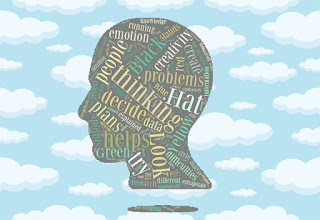 |
| Created with Tagxedo and text describing each of DeBono's Six Thinking Hats |
We start by exploring the processes. I give each students six pipe cleaners to represent the six thinking hats (red, yellow, green, blue, white and black). Pipe cleaners fascinate students and give them something to manipulate. We run through a few scenarios and limit thinking process choices. I demonstrate using three thinking hats to choose a present for my mom or best friend. Then students do it and hold up their choices of hats. We talk about process similarities and differences Then we use four or five thinking hats you'd use to create and support an argument for a new cell phone or electronic device. Then, use all six hats to convince your parents to support your college or career choice. Students delight in commonalities. Students choose the color hats, put them in order and jot down their arguments in their journals before sharing with a partner or the class.
"I picked those too."
"Why did you focus on facts last?"
"That's just what I was just thinking."
"We thinking alike!"
Conversations at students' tables focus on what we think and why we think it. Soon, we'll analyze Romeo and Juliet's thinking from key scenes in the play, but today we're playing with thinking language and building metaphorical models of our own thinking using the pipe cleaners. Students say it makes them feel smarter. I know they are already smart, but I'm delighted they are starting to see that too.
Find a sequence
Instructional Sequence:
Session 1
1. Think write. Respond to a question about thinking. Samples I've used include: How many ways do you think? What does metacognitive mean? How would you describe different types of thinking?
2. Share and discuss students' responses (write-pair-share).
3. Explain DeBono's Six Thinking Hats model. Students take notes.
4. Apply DeBono's model to decisions: use only three hats to choose a gift for a best friend or your Mom; use six hats to create an argument about your future (college, career choice, etc) to present to your parents
5. Create a metaphorical model of your own thinking and explain your model in writing being sure to say why you put the colors where you did.
Session 2
1. Turn and talk about your thinking model. Share with your table group.
2. Volunteer from each group shares out with the class.
3. Hang thinking models with explanation cards.
3. Hang thinking models with explanation cards.
4. Analyze passages from Romeo and Juliet (see handout).
5. Share analysis and discuss.
6. Connect analysis to literary criticism and reading through a psychoanalytic lens.
5. Share analysis and discuss.
6. Connect analysis to literary criticism and reading through a psychoanalytic lens.
Materials:
Pipe cleaners (white, black, red, yellow, green and blue)
index cards (to explain thinking model)
index cards (to explain thinking model)
model text for analysis
Six thinking hats handout (optional)

Six thinking hats used with well-defined and explicit Return On Investment success in corporations worldwide, Six Thinking Hats is a simple, effective parallel thinking process that helps people be more productive, focused, and mindfully involved. A powerful tool set, which once learned can be applied immediately. Find these Six Thinking Hats Techniques to learn more.
ReplyDelete